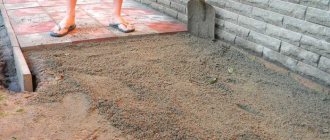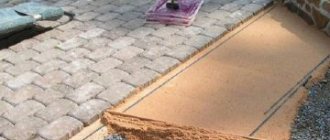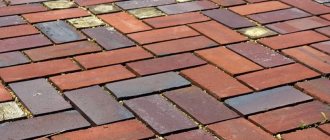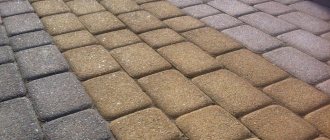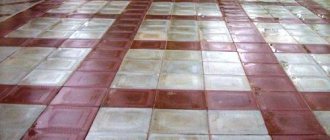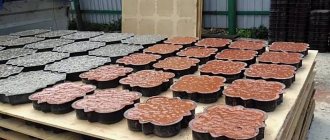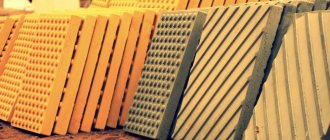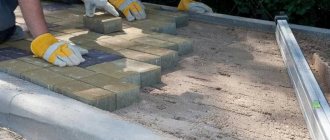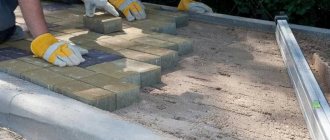The popularity of creating walkways from paving stones is growing. During its use, several technologies have been developed to work with it. But when it is necessary to effectively remove moisture from precipitation into the drainage and at the same time evenly distribute the load over the entire area, paving slabs are laid using screening. Let's look at how to correctly maintain the proportions of the sand-cement mixture. And also how to correctly lay paving stones on it.
Installation of paving stones for screening Source geosezon.ru
Features of dropout
After processing natural stone, a material remains that is commonly called screenings. In its structure it is similar to sand, but only of the largest fraction. Its grains are up to 5 mm in diameter. This product has high drainage properties.
The latter circumstance makes it possible to use screenings both for the production of paving stones and for their installation on the ground. And in the latter case, sand is often reinforced with cement. And the proportions of sand and cement for laying paving slabs are 3:1. In this case, the strength of the substrate increases significantly. And the surface can carry much greater loads.
The main advantages of dropping out:
- Does not absorb moisture.
- Not afraid of sudden temperature changes.
- Tolerates frost and extreme heat.
- Creates a perfectly even bulk layer.
- Effectively fills joints between paving stones.
- Has a low price.
- It can be purchased in any quantity. From a few bags to a large batch in bulk.
The product is well suited to persistent soils where groundwater levels are low. Otherwise, you will need to lay paving slabs on sand concrete. But before this, you need to lay geotextiles, and also pre-pour coarse crushed stone.
Screening under the tile Source upload.wikimedia.org
Types of sand
Construction material differs in the method and location of its extraction. The selection criteria are:
- Appearance.
- Fraction.
- Porosity and grain composition.
- Radioactivity.
- Price of material on the construction market.
- River sand, mined from the bottom of reservoirs or dried up river beds or lakes, has a homogeneous structure, so the layer under the tiles guarantees load-bearing and moisture infiltration throughout the entire area of laying the foundation under the street covering. The building material is widely used in decorative works (when mixed with dyes), in finishing premises and laying road surfaces, as a component of asphalt concrete mixtures.
- Quarry sand. The material is formed as a result of weathering of rocks. It contains from 10 to 12% loam. The porous surface and non-standard shape of the granules ensure tight adhesion to other ingredients of the solution.
Note! The presence of loam makes it difficult to remove atmospheric moisture.
When laying a sand cushion, the composition shrinks strongly and therefore requires careful repeated compaction.
According to GOST standards, a good indicator of radioactivity of sand masses should not exceed 1,500 Bq/kg. Indicator 370 Bq/kg. acceptable for use in landscaping the surrounding area in children's and medical institutions.
Laying technology
Let's look at how to lay paving slabs on screenings. For productive actions, it is advisable to have a concrete mixer and a vibrating tamping machine in your arsenal of standard tools. This technique will significantly speed up the entire process. It will also guarantee that the mixture for bedding will be mixed extremely thoroughly, and the density of screenings will be as high as possible.
Marking
Ideally, before work, a sketch of the future site is created, which indicates the slopes for stormwater drainage. And for excavation work, cords are stretched. They are attached to cast-offs, which are carried outside the paving area at a distance of one meter.
The cord will indicate the boundaries of the future pit. But if the plan provides for curved sections, then they are marked along the soil itself. To do this, use lime mortar or any paint.
Excavation
This operation, mandatory for any construction, is needed in order to remove the fertile layer of soil, which causes severe subsidence. All soils rich in organic matter have such properties. They are replaced with non-metallic material.
Trench under the path Source housejournal.ru
The actions are as follows:
- Black soil is removed to a depth of 40 cm.
- Small slopes for storm drains are formed in advance.
- The harvested soil is either transported or distributed throughout the garden.
- To prevent mixing with the soil, geotextiles are lined.
Sandy soil significantly reduces excavation work. It is enough to deepen the pit only 10 cm. Distributing them evenly between the screenings and the tiles, since only 5 cm of bedding will be enough. But this is only possible if the groundwater is no closer than 1.5 meters from the surface.
See also: Catalog of companies that specialize in designing and performing landscape work of any complexity
Litter
After the proportions of the mixture for laying paving slabs have been selected, backfilling begins. The work is carried out in stages. Pour a layer of 10 cm and compact it thoroughly. The next batch of screenings is laid only when the shoes no longer leave marks on the surface.
Since the depth of the pit depends on the amount of chernozem, the height of the bedding does not have a standard. Each case requires individual adjustment. But experts recommend making the thickness of the bedding layer at least 20 cm.
At the final stage, you must not forget that the contact layer of 5 cm screenings is not compacted. You also need to reserve the same amount for the paving stones themselves.
Paving tiles.
Place the solid tile on the contact layer in accordance with the layout diagram.
Installation is carried out from the curb, building wall, or blind area - laying is carried out in a ledge or in rows on straight sections, the master moves forward along the coating, installing the tiles in front of him and without disturbing the fresh layer of screenings.
Next, cut the solid tiles with a diamond blade into the required pieces and lay difficult areas near storm drains, feet, hatches, and adjacent areas to curbs or walls.
If you purchased high-quality tiles, you won’t have to adjust their height; the layer will be even. If the tiles are different in height, you can use a rubber hammer and carefully knock the tiles on top.
Video description
The video will tell you how much sand is needed to lay paving slabs per 1 m²:
Installation of curbs
Storm drainage trays are installed on one side of the path. They have reliable fixation with the soil and sufficient height above the surface to replace a full-fledged border. Therefore, the overall rigidity of the box will remain unchanged.
On the other hand, if necessary, deepen the trench. They sprinkle it with crushed stone and compact it manually. The curb is installed on cement mortar, making uniform splashes on the side surface.
Finishing layer
To level the contact layer, two methods are used. In the classic version, ordinary pieces of pipe or profile serve as beacons. They are mounted with orientation to the lower surface of the paving stones. Screenings for paving slabs are poured between them and perfectly leveled. The beacons are removed, and the remaining furrows are filled with the mixture.
The second method will require a special T-shaped narrow profile. After removing it, a narrow groove remains that does not need to be filled. And to level the mixture, you need to make your own rule for the width of the box. To do this, grooves for borders are cut out of a wide plank of wood.
Leveling the finishing layer Source voscem.ru
Path care
Colored tiles are washed with a stream of water from a hose from time to time to give them freshness. And in everyday life, the tile surface is regularly swept away from debris. If the surface is very dirty, use a stiff brush to help. And the stain is pre-treated with a washing solution.
Tile care Source ytimg.com
If a crust of ice forms in winter, the use of salt is strictly prohibited. It disrupts the structure of concrete and in the spring many chipped places form on the surface. And over time, the paving stones will begin to fall apart into pieces. Therefore, to remove ice you need to use either a scraper or special compounds.
Efflorescence often appears on paving slabs, as well as on brick. As a rule, they appear because there were a lot of salts in the water with which the solution was mixed. Or the latter were contained in large quantities in various additives. It is not difficult to fight them with the help of special means. And after just one treatment, the surface will regain its attractive appearance.
Coating operation
In operation, such paths are not picky - debris is easily removed using a fan rake, and the screenings practically do not stick to the sole. A small amount remains at “customs”, the role of which is played by a rubber mat. During heavy rainfall, the coating remains dry, as water is instantly drained through crushed stone and drainage.
Kolos75
The slope across the entire site is natural, plus the drainage pipe is buried along the edge of the parking lot at the lowest point of the site, and the drain is led beyond its boundaries into a ditch. The second pipe is laid under the path - from the house to the lower border of the site. And so the water instantly drains through the coating; even in a rainstorm, puddles practically do not form.
The site has clayey, heaving soil and a high groundwater level (GWL), and this type of paths is preferable to impenetrable concrete paths, which was confirmed by the winter that passed without harmful effects. In the spring, the paths remained in their original form; a superficial “combing” with a rake was enough to improve them.
However, the appetite comes with eating, and I wanted to fragmentarily increase functionality and decorativeness by laying large pieces of granite (25 mm thick) directly on the screening. Fortunately, there is a quarry nearby, there is plenty to choose from without overpaying to resellers.
Despite the fact that over time the pink color of granite approached gray, the coating looked presentable even in summer.
Cleaning snow in winter is also not particularly burdensome - the surface freezes into a monolith, and the snow can be shoveled away without compromising the integrity of the granite layer.
A few years later, Kolos75 paved the paths to the new future summer kitchen and beds in the same way, and with the remaining screenings he slightly updated the old coating, which had somewhat lost its appearance, but completely retained its functionality. The dirty gray shade has turned pink again and is pleasing to the eye.
The absence of borders, which “we didn’t get around to” either immediately or over time, seemed to some to be an omission, but the task was not to bring it to perfection.
Kolos75
Of course, when strict geometry and clear lines are at the forefront, a border is necessary. It will turn out finished, neat and correct on all sides. I initially had other priorities, and even now it’s not important to adjust to the ideal - practicality is primary, the ability to move around the site without the risk of falling into the mud.
